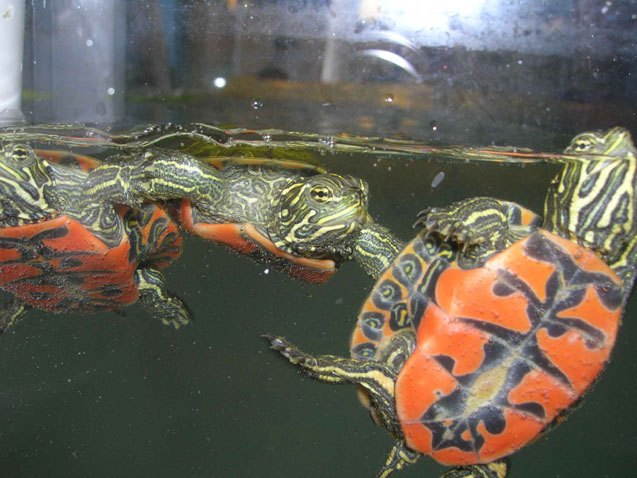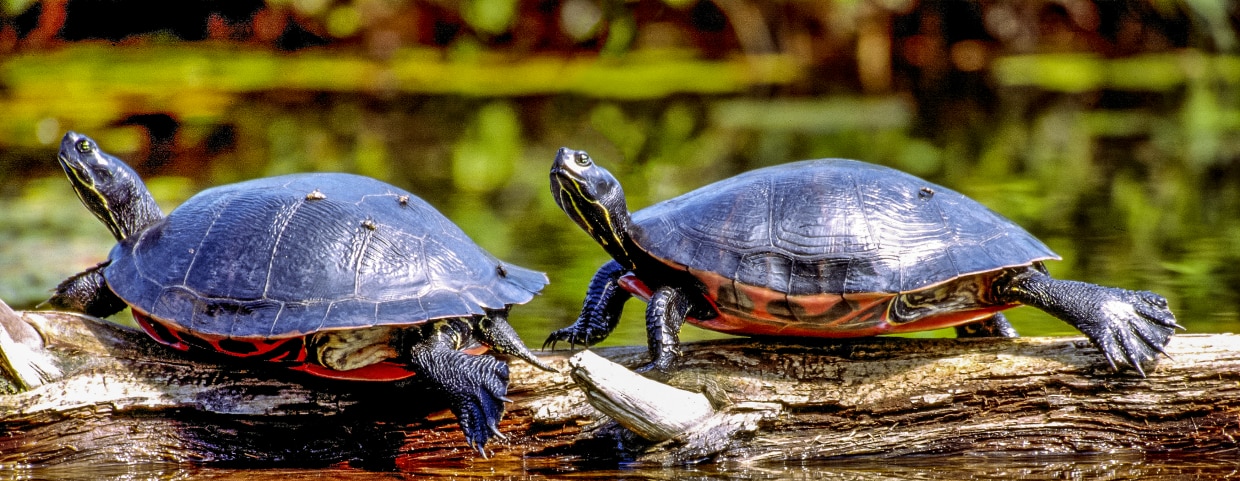Red bellied turtles eat aquatic plants, insects, and small fish. They also consume algae and crustaceans.
Red bellied turtles, known scientifically as Pseudemys rubriventris, are omnivorous creatures. Their diet consists of a variety of food sources found in freshwater habitats. These turtles play a crucial role in maintaining the ecological balance of their environment. They help control the population of insects and small fish while also promoting the growth of aquatic plants.
Their eating habits ensure that both plant and animal life thrive in their ecosystems. Red bellied turtles are fascinating to observe and study due to their diverse diet and significant environmental impact. Understanding their dietary preferences can aid in their conservation and the preservation of their habitats.
Introduction To Red Bellied Turtles
Red Bellied Turtles are fascinating creatures. They are known for their unique red-colored bellies. Understanding their diet is essential for their care and well-being. Let’s dive into the world of Red Bellied Turtles.
Brief Overview
Red Bellied Turtles are semi-aquatic reptiles. They are commonly found in freshwater habitats. These turtles have distinctive red markings on their undersides. They are medium-sized and can grow up to 12 inches. Their lifespan can reach up to 40 years with proper care.
Habitat And Behavior
Red Bellied Turtles prefer slow-moving waters. They are often seen in ponds, rivers, and marshes. These turtles enjoy basking in the sun on logs or rocks. They are omnivores and have diverse eating habits. Understanding their habitat can help in providing the best care.
| Habitat | Behavior |
|---|---|
| Freshwater ponds and rivers | Basking on logs and rocks |
| Marshes and swamps | Omnivorous diet |
Red Bellied Turtles are active during the day. They are known to be good swimmers. These turtles are also good climbers. They often climb onto rocks for sunbathing. Their behavior is influenced by their surroundings.
- Freshwater Ponds: Common habitat.
- Basking: Essential for their health.
- Omnivores: They eat both plants and animals.
- Climbers: They climb onto rocks to sunbathe.
Understanding their habitat and behavior helps in providing the right environment. This ensures the health and happiness of Red Bellied Turtles.
Natural Diet In The Wild
Red Bellied Turtles thrive on a diverse diet in the wild. They are omnivorous and eat both plant-based and animal-based foods. Understanding their natural diet helps in providing proper care for them in captivity.
Plant-based Foods
Red Bellied Turtles consume various plants in the wild. They love eating aquatic vegetation. Some common plants they eat include:
- Water lilies
- Duckweed
- Algae
- Water lettuce
These plants provide essential vitamins and minerals. They help in keeping the turtle healthy. Red Bellied Turtles also eat fruits and vegetables. They enjoy munching on:
- Watermelons
- Leafy greens
- Cucumbers
- Carrots
Animal-based Foods
Red Bellied Turtles also eat various animal-based foods. They are skilled hunters and scavengers. Their animal-based diet includes:
- Insects
- Small fish
- Crustaceans
- Snails
These foods provide protein and other nutrients. They help in muscle growth and overall health. Red Bellied Turtles are opportunistic feeders. They eat whatever animal-based food they find.
In the wild, Red Bellied Turtles balance their diet. They consume both plant-based and animal-based foods. This diverse diet ensures they get all necessary nutrients.
Seasonal Dietary Changes
Red Bellied Turtles have a diverse diet that changes with the seasons. These changes ensure they get the right nutrients throughout the year. Understanding these seasonal dietary changes helps in providing proper care for these turtles.
Spring And Summer Diet
During spring and summer, Red Bellied Turtles are more active. They require a diet rich in protein and vitamins.
- Insects: Crickets, mealworms, and beetles.
- Fish: Small fish like guppies or minnows.
- Plants: Aquatic plants such as duckweed and water lettuce.
- Fruits: Strawberries, blueberries, and melon slices.
Turtles also enjoy basking in the sun during these months. This helps with their digestion and vitamin D synthesis.
Fall And Winter Diet
In fall and winter, the activity level of Red Bellied Turtles decreases. Their diet shifts to more fibrous and carbohydrate-rich foods.
- Vegetables: Carrot slices, zucchini, and leafy greens.
- Grains: Cooked rice and oats.
- Pellets: High-fiber turtle pellets available in pet stores.
During colder months, they eat less frequently. It’s important to monitor their food intake to ensure they stay healthy.
A consistent diet helps maintain their shell strength and overall health. Understanding these seasonal changes is key to their well-being.
Diet In Captivity
Red bellied turtles have specific dietary needs. In captivity, they need a balanced diet for optimal health. Understanding their diet helps ensure they thrive.
Recommended Foods
A balanced diet includes both animal and plant-based foods. For protein, offer:
- Crickets
- Mealworms
- Earthworms
For plant-based foods, include:
- Leafy greens like kale and collard greens
- Aquatic plants such as duckweed
- Vegetables like carrots and squash
Foods To Avoid
Certain foods can be harmful. Avoid feeding:
- Processed meats
- Dairy products
- Foods high in fat and sugar
Also, avoid feeding them:
- Iceberg lettuce (low nutritional value)
- Spinach (high in oxalates)
A well-balanced diet is key. Providing the right foods ensures a healthy turtle.
Nutritional Requirements
Red bellied turtles need a balanced diet. They thrive on specific nutrients. Their diet must include essential vitamins, minerals, and proteins. This helps them stay healthy and active. Ensuring the right food keeps their shell and body strong.
Essential Vitamins
Vitamins play a crucial role in a red bellied turtle’s diet. They need Vitamin A for eye health and a strong immune system. Lack of Vitamin A can cause swollen eyes and respiratory problems. Leafy greens like kale and dandelion greens are good sources.
Vitamin D3 is important for calcium absorption. Without it, turtles can suffer from metabolic bone disease. Ensure they get enough sunlight or UVB light. This helps them synthesize Vitamin D3.
Minerals And Proteins
Minerals are vital for a turtle’s growth and shell strength. Calcium is the most important mineral. Turtles need it for their bones and shells. Offer cuttlebone or calcium blocks in their tank. Foods like collard greens and mustard greens are also rich in calcium.
Proteins help in growth and muscle development. Baby turtles need more protein than adults. Feed them insects, fish, and commercial turtle pellets. As they grow, reduce protein intake and increase plant-based foods. Adult turtles should have a diet with more vegetables.
| Food Type | Examples | Nutrients |
|---|---|---|
| Leafy Greens | Kale, Dandelion Greens | Vitamins A and C, Calcium |
| Protein Sources | Insects, Fish, Pellets | Proteins, Omega-3 |
| Vegetables | Carrots, Squash | Vitamins, Fiber |
| Calcium Sources | Cuttlebone, Collard Greens | Calcium |

Credit: www.petguide.com
Feeding Frequency And Portions
Understanding the feeding frequency and portion control for red bellied turtles is crucial. These turtles need a balanced diet to stay healthy. Overfeeding or underfeeding can lead to health problems.
Daily Feeding Schedule
Red bellied turtles should be fed once a day. Young turtles need more frequent feedings compared to adults. For hatchlings, feed twice a day. As they grow, switch to once daily.
Here’s a simple feeding schedule:
- Hatchlings: Morning and evening.
- Juveniles: Once a day, preferably in the morning.
- Adults: Every other day.
Portion Control
Portion control is vital for red bellied turtles. Overfeeding can cause obesity and health issues. Underfeeding can lead to malnutrition. The right portion depends on the turtle’s size and age.
Use this table to guide you:
| Age | Portion Size |
|---|---|
| Hatchlings | Small amount, size of their head. |
| Juveniles | Amount equal to their head and neck. |
| Adults | Portion the size of their head. |
Remember, a balanced diet includes vegetables, pellets, and proteins. Feed leafy greens, turtle pellets, and occasional insects or fish. Avoid feeding too many high-fat foods.
Health Implications Of Diet
Red bellied turtles thrive on a balanced diet. Their health depends on what they eat. An improper diet can lead to health issues. Knowing what to feed them is crucial. Let’s explore the dietary needs and health implications.
Common Dietary Issues
Feeding red bellied turtles the wrong food can cause problems. Here are some common issues:
- Vitamin A Deficiency: Leads to swollen eyes and respiratory infections.
- Overfeeding: Causes obesity and liver disease.
- Calcium Deficiency: Results in soft shells and weak bones.
Preventative Measures
Prevent dietary issues by providing a balanced diet. Follow these tips:
| Food Type | Frequency |
|---|---|
| Leafy Greens | Every day |
| Proteins (fish, insects) | 2-3 times a week |
| Fruits | Once a week |
Always ensure fresh water is available. Use calcium supplements if needed. Monitor their weight and health regularly. A balanced diet will keep your turtle healthy and happy.
Credit: www.quora.com

Credit: www.mass.gov
Conclusion
Red bellied turtles thrive on a balanced diet of aquatic plants, insects, and fish. Providing diverse food ensures their health. Remember to avoid processed foods and maintain a clean habitat. Understanding their dietary needs helps in fostering a long and happy life for your red bellied turtle.
